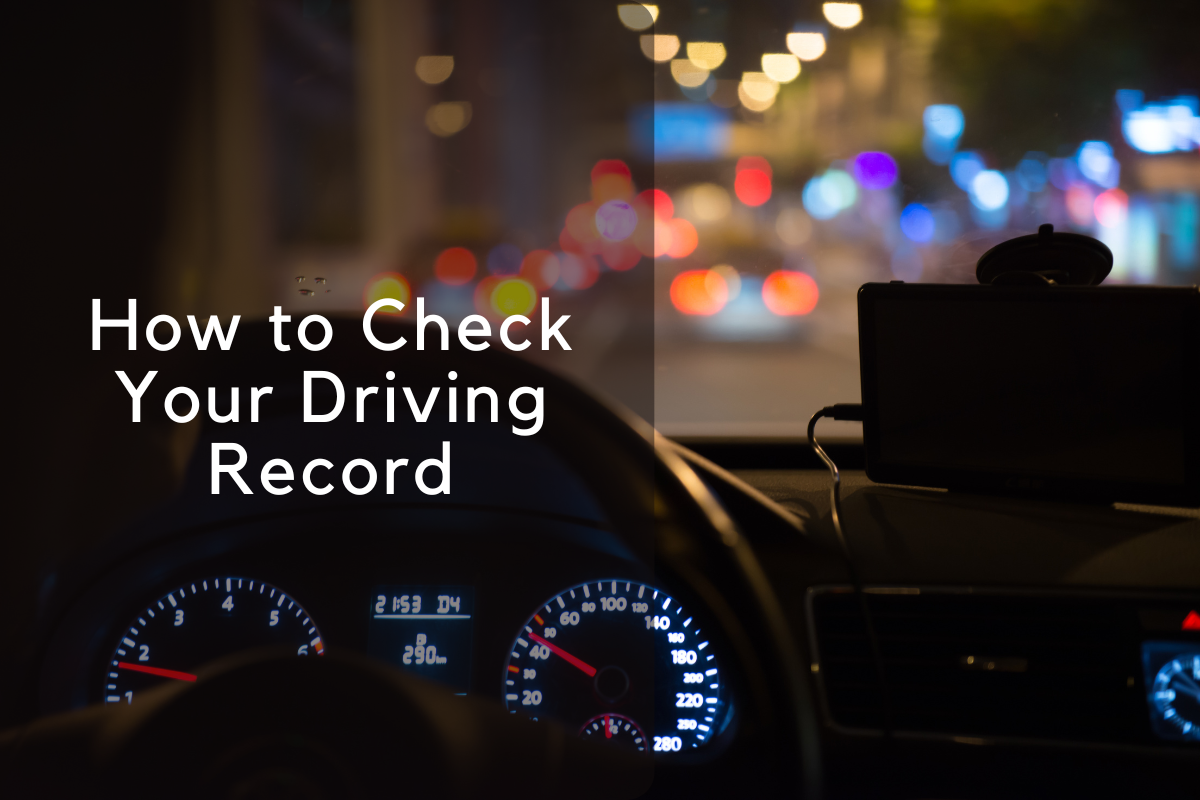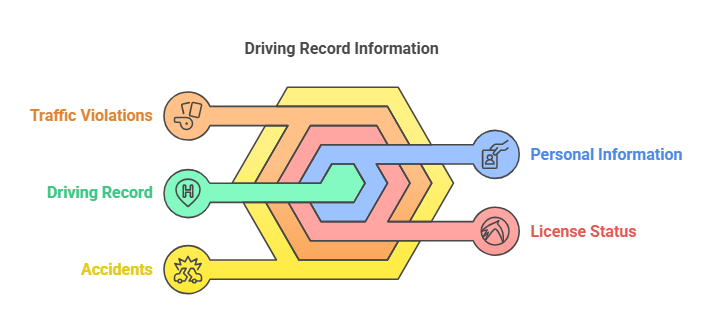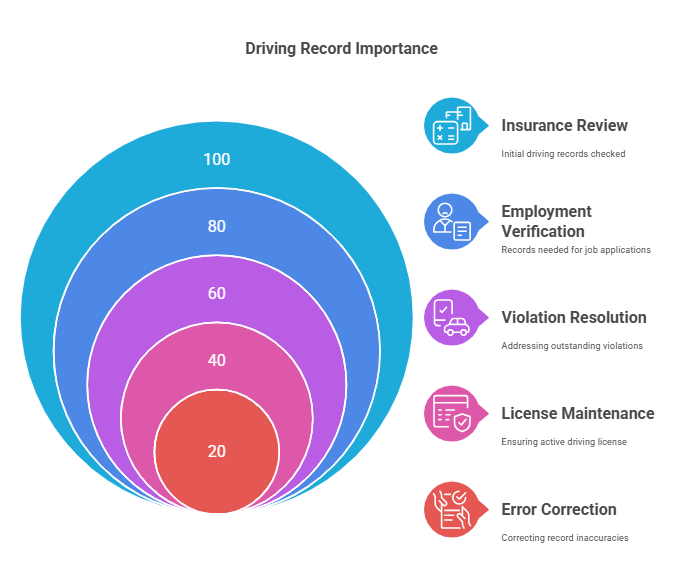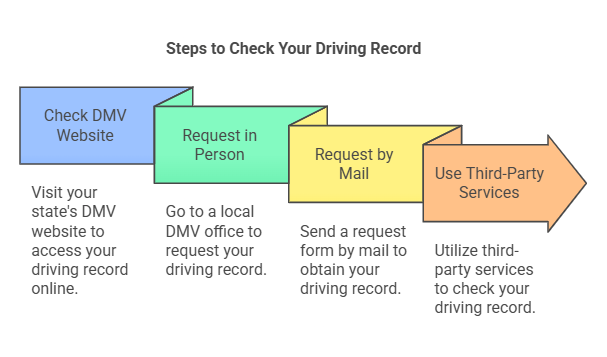Table of Contents
ToggleWhat is a Driving Record and Why Should You Check It?

A driving record is a detailed account of your driving history, maintained by the Department of Motor Vehicles (DMV) or a similar regulatory agency in your state. It includes a wide range of information about your driving behavior, such as violations, accidents, license status, and any points that have accumulated on your license. Understanding your driving record is crucial for various reasons, as it can affect everything from your insurance premiums to your eligibility for certain jobs.
What Information is Included in Your Driving Record?

Your driving record can contain various pieces of information depending on the state or country where it is issued. Common details that are typically found on a driving record include:
- Personal Information: Your name, address, and driver’s license number.
- License Status: Whether your driver’s license is valid, suspended, revoked, or expired.
- Traffic Violations: Any citations or fines you have received for traffic offenses, such as speeding tickets, DUI charges, or running red lights.
- Accidents: Details of any accidents you were involved in, including whether you were at fault.
- Points System: Most states use a points system to track violations. Points accumulate for traffic offenses and can result in penalties, including license suspension.
- License Classifications and Endorsements: Information about the types of vehicles you’re qualified to drive (e.g., passenger vehicles, commercial vehicles) and any special endorsements (e.g., motorcycle licenses).
- DUI/DWI Records: If you have been convicted of driving under the influence of alcohol or drugs, this will appear on your driving record.
Why Should You Check Your Driving Record?

Checking your driving record regularly is an important practice for several reasons:
- For Insurance Purposes: Insurance companies often review your driving history when determining your premiums. A clean driving record can help you qualify for lower rates, while a record with violations or accidents may result in higher premiums. By checking your record, you can ensure that no mistakes or outdated violations are impacting your rates.
- Employment Applications: Certain jobs, especially those that involve driving, require a clean driving record. Employers may request a driving record to verify your qualifications. For example, commercial drivers, delivery personnel, and chauffeurs must have a safe driving history. Checking your driving record ahead of time can ensure that you are prepared for these requests.
- Resolving Traffic Violations: If you receive a ticket or are involved in an accident, your driving record may reflect these events. Checking your record can help you stay on top of any outstanding fines, unpaid tickets, or violations that need to be addressed.
- Maintaining License Status: Your driving record helps you keep track of your license status, ensuring that it remains active and valid. If you accumulate too many points, your license may be suspended or revoked, so regularly checking your driving record can prevent surprises.
- Correcting Errors: Mistakes can happen, and your driving record may contain errors, such as incorrect accident reports or violations that were not your fault. By reviewing your record, you can catch these errors early and correct them before they become an issue.
When Should You Check Your Driving Record?
You should check your driving record in the following scenarios:
- Before Applying for Insurance: To ensure that the information provided to the insurance company is accurate.
- Before Job Applications: If you’re applying for a driving-related job or one that involves vehicle operation.
- When Dealing with Traffic Violations: If you’ve received a traffic ticket or been in an accident, it’s a good idea to check your record to ensure everything is correct.
- To Monitor Your Driving Habits: Regularly checking your record can give you an overview of your driving habits and help you avoid accumulating points or violations.
How to Check Your Driving Record: A Step-by-Step Guide
Now that you understand the importance of checking your driving record, let’s walk through how to do it. There are several ways to access your driving record, depending on your location, whether online, in-person, or through third-party services. In this section, we’ll guide you through the most common methods for obtaining your driving record and the necessary information you’ll need to do so.
Step-by-Step Guide to Checking Your Driving Record

- Check Your State DMV or Licensing Authority’s Website
- The most direct way to check your driving record is by visiting the Department of Motor Vehicles (DMV) or your state’s licensing authority website. Nearly all states provide online services for accessing your driving record.
- Steps to follow:
- Go to your state’s DMV website or the relevant licensing authority’s website.
- Look for the section labeled “Driver Records” or “Driving History.”
- Some states allow you to check your record online immediately, while others may require you to create an account.
- You will need to provide personal information, such as your driver’s license number, date of birth, and possibly your Social Security Number (SSN).
- Follow the prompts to request a copy of your driving record, which may be available for download or sent to you by mail.
- Request Your Driving Record in Person
- If you prefer to handle things in person or if your state doesn’t offer online services, you can visit a local DMV office to request your driving record.
- Steps to follow:
- Visit your nearest DMV or equivalent office.
- Bring identification, such as your driver’s license and other supporting documents (e.g., proof of address).
- Fill out a request form for your driving record, which may include a fee for processing.
- Depending on the office, you may receive a physical copy of your record on the spot or via mail.
- Request Your Driving Record by Mail
- If you can’t visit the DMV in person or if online services are unavailable, many states allow you to request your driving record by mail.
- Steps to follow:
- Download or request a mail-in form from your state’s DMV website.
- Complete the form with accurate details, including your driver’s license number, name, and date of birth.
- Mail the completed form to the address provided on the DMV website, along with any required payment (usually by check or money order).
- Wait for your driving record to be sent to you, which may take several days or weeks, depending on your state.
- Using Third-Party Services to Check Your Driving Record
- In addition to official DMV channels, third-party services also offer driving record reports. These services can be particularly useful if you need access to your record quickly or if you are trying to check records from multiple states.
- Steps to follow:
- Search online for reputable third-party services that provide access to driving records.
- Choose a service that fits your needs, and make sure to review its terms and privacy policies.
- You will need to provide personal information such as your name, driver’s license number, and payment details.
- Some services offer immediate access to digital records, while others may mail physical copies.
- Important: While third-party services are convenient, they may charge higher fees than government-run websites. Always ensure the service is trustworthy before sharing any personal information.
Required Documents and Information for Checking Your Driving Record
When requesting your driving record, whether online, in person, or via mail, you will need to provide certain pieces of information to verify your identity and ensure the accuracy of your record:
- Driver’s License Number: This is the most critical piece of information. Without it, the DMV or service may not be able to locate your record.
- Full Name: Your legal name as it appears on your driver’s license.
- Date of Birth: This helps further confirm your identity and distinguish you from others with similar names.
- Social Security Number (Optional): Some states may require your SSN to verify your identity, although not all states ask for it.
- Payment Information: Depending on the method, there may be a fee for obtaining your record, which typically ranges from $5 to $20. Payment options include credit cards, checks, or money orders.
Methods to Check Your Driving Record Based on Location
While the process for checking your driving record is similar across the United States, each state has its specific process. Below is a summarized list of how to check your driving record in different ways, based on your location:
| Method | State-Specific Process |
|---|---|
| Online | Most states offer online services through their DMV websites. |
| In Person | Visit your local DMV or licensing authority office with ID. |
| By Mail | Download and submit a request form to the DMV by mail. |
| Third-Party Services | Use reputable services that aggregate data from multiple states. |
Additional Tips for Checking Your Driving Record
- Verify the Accuracy of Your Record: It’s essential to check for any errors that might be present in your record, such as incorrect dates, violations that don’t belong to you, or accidents that were not your fault. If you notice any discrepancies, you can usually dispute the information by contacting your state’s DMV.
- Regularly Monitor Your Record: If you are concerned about accumulating points or other issues, it’s a good idea to check your record periodically. This can help you address issues before they escalate, such as your license being suspended or your insurance rates increasing.
- Understand What’s On Your Record: Be aware of how different violations and points affect your driving privileges. Accumulating too many points in some states may lead to a suspended license, which can have long-term consequences. Staying informed about what’s on your record helps you make more informed decisions.
Common Questions, Best Practices, and Conclusion on Checking Your Driving Record
Checking your driving record is an essential task that can help you maintain a clean driving history and prevent unwanted surprises. In this section, we’ll answer common questions regarding driving records, offer best practices for keeping your record clean, and summarize the key takeaways for checking and understanding your driving record.
Common Questions About Driving Records
How often should I check my driving record?
It’s a good practice to check your driving record at least once a year, especially if you’ve been involved in any traffic violations or accidents. If you’ve recently moved to a new state or experienced any changes in your driving history, such as a DUI conviction or license suspension, it’s a good idea to check your record more frequently.
For insurance purposes or job applications, you may need to check it more often to ensure that the information you provide is accurate and up-to-date.
How much does it cost to check my driving record?
The cost to check your driving record can vary depending on the state and the method used. On average, it can range from $5 to $20 for an online request through the DMV or a third-party service. Some states offer discounted rates for multiple-year reports or for checking records in person. Be sure to check the specific fees in your state before requesting your record.
What should I do if I find an error on my driving record?
If you find any discrepancies or errors on your driving record, such as incorrect traffic violations or accidents that weren’t your fault, you should immediately contact the DMV or licensing authority in your state. Most states have a formal process for disputing errors on your driving record. This could involve submitting proof of the mistake, such as court documents or a police report, to have the error corrected.
How long does a traffic violation stay on my record?
The duration that a traffic violation remains on your record depends on the type of violation and your state’s laws. Typically, minor violations, such as speeding tickets, may stay on your record for three to five years. Serious offenses, like DUIs or reckless driving, may remain for a much longer period, sometimes up to 10 years. It’s important to know the specifics of your state’s laws and how violations impact your record over time.
Can my driving record affect my job prospects?
Yes, your driving record can impact job opportunities, particularly if the job requires you to operate a vehicle. Employers in industries such as transportation, delivery, or public service may perform a driving record check as part of the hiring process. A clean driving record can increase your chances of securing these positions, while a record with multiple violations or accidents could disqualify you from certain jobs.
Can I check someone else’s driving record?
In most cases, you cannot check someone else’s driving record without their permission. However, there are some exceptions, such as if you are an employer performing a background check on a potential hire or if you are involved in a legal matter that requires access to the record. Always check the laws in your state regarding obtaining someone else’s driving record.
Best Practices for Maintaining a Clean Driving Record
Maintaining a clean driving record is not only important for your safety but also for your reputation and financial well-being. Here are some best practices to help you keep your record clean:
- Obey Traffic Laws: Always follow the traffic laws, including speed limits, stop signs, and parking regulations. Avoid aggressive driving behaviors, such as tailgating or running red lights, which can lead to accidents and violations.
- Attend Defensive Driving Courses: If you’ve accumulated points or received a traffic ticket, consider enrolling in a defensive driving course. Many states offer these courses as a way to reduce points on your driving record or lower your insurance premiums.
- Address Violations Promptly: If you receive a ticket or citation, don’t ignore it. Pay the fine or appear in court if required. Ignoring tickets or failing to address violations can lead to additional penalties, such as license suspension or higher insurance rates.
- Avoid Drinking and Driving: A DUI conviction can have long-lasting effects on your driving record and your ability to find employment. Always designate a driver or use public transportation if you plan to consume alcohol.
- Keep Track of Points: Many states use a point system to track violations. Make sure you understand how the points system works in your state and how many points you can accumulate before facing penalties like license suspension.
- Consider Insurance Discounts for a Clean Record: Many insurance companies offer discounts for maintaining a clean driving record. By staying violation-free, you can benefit from lower premiums, which can save you money over time.
Conclusion
In conclusion, checking your driving record is an essential part of managing your driving history and ensuring that the information is accurate. Whether you need to check it for insurance purposes, job applications, or to resolve potential errors, it’s important to understand the process and how to maintain a clean record. By regularly reviewing your driving record, addressing any violations promptly, and following best practices for safe driving, you can protect your license and enjoy lower insurance rates and job opportunities that require a clean driving history.
Remember to use the proper channels to check your driving record—either through your state’s DMV, a third-party service, or in person—and keep track of any errors or changes that might affect your record. With a proactive approach, you can ensure your driving history stays accurate and secure.
